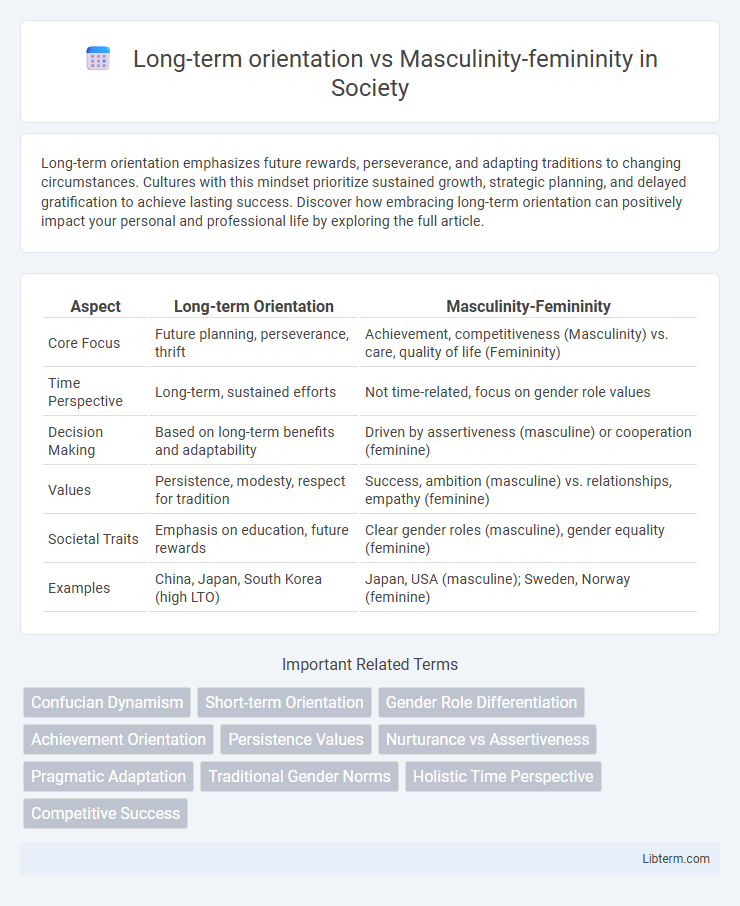Long-term orientation emphasizes future rewards, perseverance, and adapting traditions to changing circumstances. Cultures with this mindset prioritize sustained growth, strategic planning, and delayed gratification to achieve lasting success. Discover how embracing long-term orientation can positively impact your personal and professional life by exploring the full article.
Table of Comparison
| Aspect | Long-term Orientation | Masculinity-Femininity |
|---|---|---|
| Core Focus | Future planning, perseverance, thrift | Achievement, competitiveness (Masculinity) vs. care, quality of life (Femininity) |
| Time Perspective | Long-term, sustained efforts | Not time-related, focus on gender role values |
| Decision Making | Based on long-term benefits and adaptability | Driven by assertiveness (masculine) or cooperation (feminine) |
| Values | Persistence, modesty, respect for tradition | Success, ambition (masculine) vs. relationships, empathy (feminine) |
| Societal Traits | Emphasis on education, future rewards | Clear gender roles (masculine), gender equality (feminine) |
| Examples | China, Japan, South Korea (high LTO) | Japan, USA (masculine); Sweden, Norway (feminine) |
Understanding Long-term Orientation: Definition and Key Features
Long-term orientation refers to a cultural value emphasizing perseverance, thrift, and adapting traditions to modern circumstances to achieve future rewards, contrasting with short-term orientation which prioritizes immediate results. Key features include sustained efforts, respect for tradition, and a pragmatic approach to overcoming challenges, often found in East Asian societies. In contrast, masculinity-femininity dimensions focus on competitive success versus care and quality of life, highlighting different aspects of cultural values unrelated to the time horizon emphasized in long-term orientation.
Masculinity-Femininity: Concept and Cultural Implications
Masculinity-femininity, a core dimension in Hofstede's cultural framework, distinguishes societies valuing competitiveness, assertiveness, and material success (masculine) from those prioritizing care, cooperation, and quality of life (feminine). Cultures with high masculinity emphasize achievement, ambition, and gender role differentiation, impacting workplace behavior and social expectations. In contrast, feminine cultures foster equality, nurturing relationships, and work-life balance, influencing communication styles and conflict resolution strategies across different societies.
Origins and Historical Context of Both Dimensions
Long-term orientation and masculinity-femininity are cultural dimensions developed by Geert Hofstede through extensive cross-national research in the late 20th century. Long-term orientation traces its origins to Confucian values emphasizing perseverance, thrift, and future-focused planning prominent in East Asian societies. Masculinity-femininity stems from traditional gender role distinctions influenced by industrialization and Western social norms, highlighting competitiveness and achievement versus care and quality of life.
Impact of Long-term Orientation on Societal Values
Long-term orientation emphasizes perseverance, thrift, and adapting traditions to modern contexts, profoundly shaping societal values toward future rewards rather than immediate gratification. Societies with high long-term orientation tend to prioritize education, sustained efforts, and strategic planning, contrasting with masculine cultures that value assertiveness, achievement, and material success. The impact of long-term orientation fosters collective well-being and long-term societal growth, often aligning more with nurturing traits typically associated with femininity, focusing on quality of life and social harmony.
How Masculinity-Femininity Shapes Work Environments
Masculinity-femininity dimensions profoundly influence work environments by shaping organizational values and employee behavior; masculine cultures prioritize competition, achievement, and assertiveness, fostering performance-driven workplaces, while feminine cultures emphasize cooperation, care, and work-life balance, promoting supportive and inclusive atmospheres. In masculine work settings, success is often measured by visible accomplishments and status, driving a dynamic, goal-oriented environment; feminine workplaces encourage collaboration and consensus, enhancing employee well-being and satisfaction. Understanding these cultural dimensions helps multinational corporations tailor management practices, improve team dynamics, and increase productivity across diverse global offices.
Comparing Decision-making Styles: Future vs. Present Focus
Long-term orientation emphasizes future-focused decision-making with an emphasis on perseverance, thrift, and adapting to changing circumstances, while masculinity-femininity contrasts assertive, competitive choices typical of masculine cultures with cooperative, caring decisions in feminine cultures. In long-term oriented societies, decisions prioritize sustainable outcomes and delayed gratification, whereas masculine cultures favor goal-driven, achievement-oriented approaches, and feminine cultures prioritize consensus and quality of life. These cultural frameworks shape how organizations balance immediate results versus strategic planning to align with societal values and expectations.
Effects on Family Structure and Gender Roles
Long-term orientation fosters family structures emphasizing perseverance and sustained commitments, leading to adaptive gender roles that prioritize collective welfare over individual assertiveness. Masculinity-femininity influences gender dynamics by defining societal expectations, where masculine cultures endorse competitive, achievement-based roles, while feminine cultures promote nurturing and cooperation within family units. The interplay between these dimensions shapes how families balance traditional responsibilities with evolving gender norms, affecting intergenerational relationships and role flexibility.
Influence on Education and Learning Approaches
Long-term orientation influences education by emphasizing perseverance, adaptability, and future rewards, encouraging students to engage in sustained learning and self-discipline. Masculinity-femininity impacts learning approaches by shaping competitive, achievement-focused environments in masculine cultures, whereas feminine cultures prioritize cooperation, empathy, and holistic understanding. Together, these cultural dimensions determine curriculum design, student motivation, and teacher-student interactions, affecting educational outcomes worldwide.
Business Practices: Strategic Planning and Leadership
Long-term orientation in business emphasizes strategic planning with a focus on future rewards, promoting perseverance and adaptability in leadership decisions. Masculinity-femininity influences leadership styles, where masculine cultures prioritize competition, achievement, and assertiveness, while feminine cultures emphasize collaboration, care, and consensus-building. Integrating long-term perspectives with appropriate masculine or feminine leadership traits enhances organizational sustainability and employee motivation.
Global Case Studies: Contrasts and Real-world Applications
Long-term orientation emphasizes perseverance, thrift, and adapting to changing circumstances, while masculinity-femininity focuses on competitive success versus cooperation and quality of life. Global case studies reveal how countries like Japan exemplify long-term orientation with high perseverance and planning, contrasting with the United States, which leans toward masculinity by valuing assertiveness and achievement. Real-world applications in international business highlight tailoring leadership styles and negotiation tactics according to these cultural dimensions to improve cross-cultural collaboration and organizational effectiveness.
Long-term orientation Infographic

 libterm.com
libterm.com